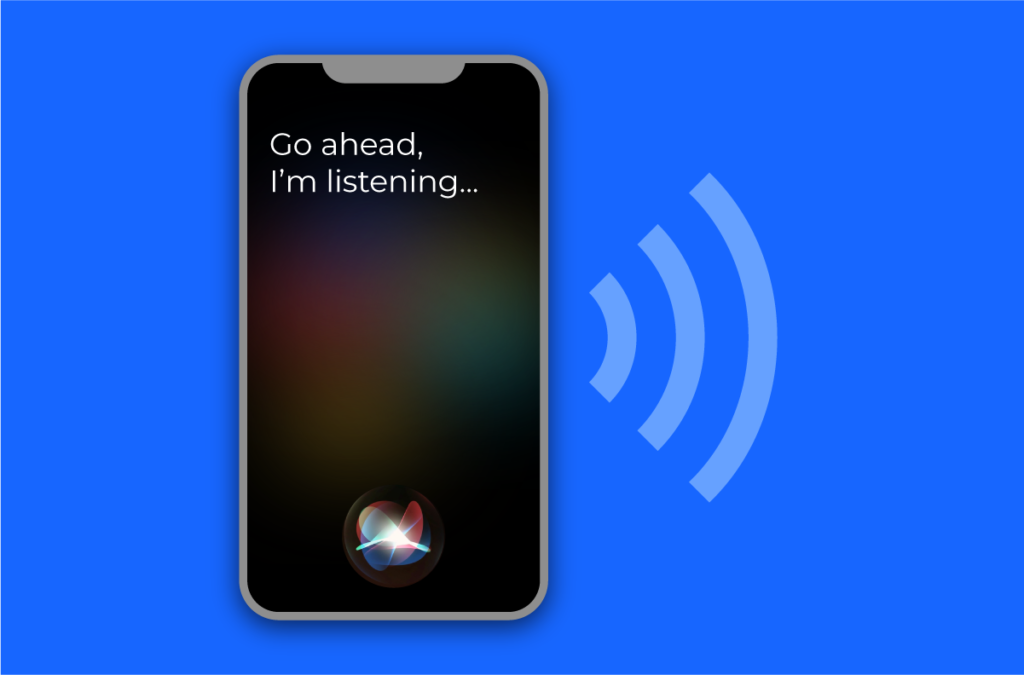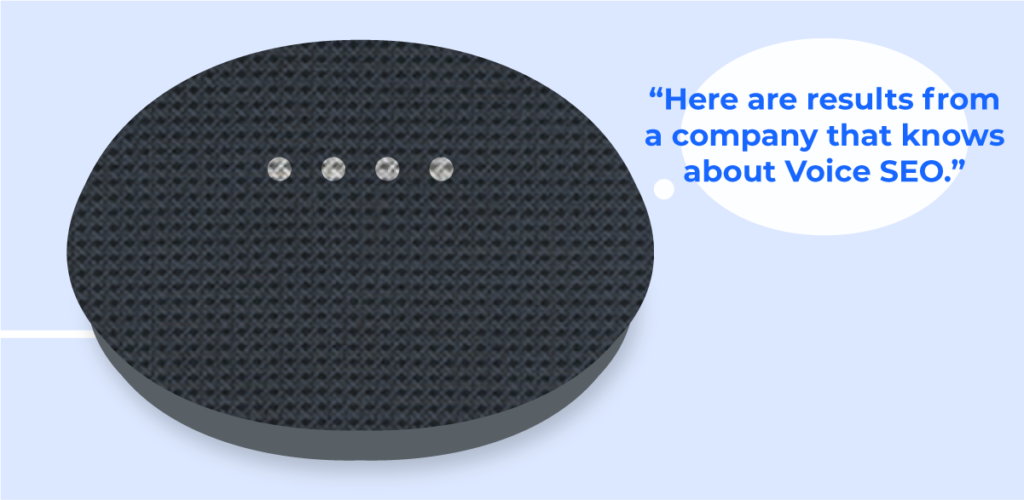The New Voice in SEO: How To Rank for Voice Search Results
Alexa, start writing blog.
The inception of voice-controlled devices seems like a new technology, but in reality, machines have been listening to us for almost 70 years. In 1952, Bell Laboratories designed a system known as Audrey which could recognize a single voice speaking digits aloud. Of course, in the last ten years, we’ve seen this expansion reach new heights with devices like Google Home, Amazon’s Alexa, Apple’s Siri, and more. Now we’ve got everything from voice-activated vacuum cleaners to voice-activated blog writers (I respond well to direct commands to write more content).
Though the advent of these voice technologies may no longer be novel, there still is much to be learned from marketers when it comes to utilizing the technology to sell their products or services. All of the new meta descriptions, image tags, edits to improve site speed, and mobile optimization have done wonders to help your overall SEO, but have you prepared your brand to rank higher for voice searches?
Today, we’re going to take a deep dive into the wonderful world of voice search optimization, and tell you all you need to know to have your company ranking higher for key voice searches.
Ok, Google. Tell us what we need to know.
What is Voice SEO and Why Does it Matter?

In a nutshell, Voice SEO refers to the optimization of keywords and keyword phrases for searches using devices that listen (cell phones, tablets, home systems, etc.). The reality is that people “search” differently when typing versus when speaking, and preparing your website to rank higher for these searches is an important consideration.
So, why should you care?
A Gartner study predicts that close to 30% of all browsing sessions will include voice search by the end of this year, and Google notes that 27% of the online global population is using voice search on mobile. When you break it down, one of the most important parts of any marketing strategy is to meet individuals where they are. With the increased use of voice search, it’s important for your business to meet prospective customers where they’re looking. If you need even more confidence that Voice SEO is something worth caring about, 62% of smart speaker owners who regularly use them will make a purchase with voice technology in the next month.
What are People Searching for with Voice Technology?

When we discuss SEO, we usually describe three different types of search queries that people make:
- Transactional
- Informational
- Navigational
With voice search, the three different categories are the same, but the way in which people ask Google or Bing is what’s new. So, people may still be looking for where they can buy a new pair of shoes, what the current events or newsworthy happenings are, and how to get to the pizza place in a new town, but the manner in which they ask is a bit different.
The common practice with traditional SEO has been to focus on keywords, but in a voice search, people are much more likely to seek search results by asking a question or being more conversational. For example, the subtitle of this section of the blog. By having this read “What are people searching for with voice technology,” I may have luck in driving in people searching for this exact search on voice (very meta, I know).
An even better example is the voice search I did last week when looking for bulk twist ties. If I was on a computer or a web browser, I may have just typed “twist ties” to find what I needed. But, when I asked my Google Home, I said “where can I buy twist ties?” which led me to a result I followed up on.
A recent survey from Adobe Analytics sought to find out what people are searching for the most on smart speakers (Amazon Alexa, Google Home, etc.). The results found these categories to be the most common:
- Music (70%)
- Weather Forecast (64%)
- Fun Questions (53%)
- Online Search (47%)
- News (46%)
- Directions (34%)
Having a better understanding of both what your audience is searching for, and how they’re choosing to search for it on a voice-activated device, is an important way to gear your site’s content to rank well on voice searches.
How to Show Up in Voice Search Results

One of the biggest differences between typed-out search queries and voice searches is that you’re trusting your ‘virtual assistant’ (Siri, Alexa, etc.) to find the best result for you when you ask a question to your device. When you type out a question, you’re in the driver’s seat when it comes to scrolling through results and selecting a response. With that in mind, it’s much more difficult to show up for voice search results, making it all the more important to reside in the #1 spot. So, how do you get there? Here are some ideas to start:
Write Content that Answers Questions

If you haven’t heard of ‘rich answers,’ yet, you’re about to. A rich answer is a snippet of information displayed at the top of search results that seeks to answer a search query without making a user click on a link. It’s estimated that for over 30% of search queries, a rich result will show. For voice searches, that number rises even more, as these snippets of information provide a great launching pad for Siri, Alexa, and other virtual assistants to pull from. An example of a rich answer can be seen above in the query results for “what are rich answers.” So if you want to show up for search queries, consider finding ways to get rich answers to search queries.
How can you do so? Here are a few quick & easy tips:
- Find ideas for new featured snippets. When you type out a question in Google, you may see a featured snippet or you may not. If you don’t, you can realize an opportunity for your content to show there. If you do, you can look at what else people ask for (in the ‘People also ask’ section) to see if there are any snippets showing up in those results. If not, it may signal an opportunity for you to show up for these questions.
- Create some sort of FAQs page on your site. Make sure to develop content on your website that answers questions. When Google is looking for results to questions to include in these snippets, or rich answers, they may come across your page and see it as an opportunity.
- Keep your answers succinct. The average answer length for all analyzed assistants is 23 words. By keeping your answers short and simple (and not leaving room for it to be cut off), you have a better chance of showing as the featured result or rich answer.
These are a few simple recommendations that can have a big impact on getting your content to appear in the rich answers section, and therefore getting you closer to showing up for voice searches.
Think Local
According to Review42, 58% of people have used voice search to find information about a local business. If you have any sort of storefront or desire to show up in your local market, it’s important to get the tools in place to rank for voice searches. Think about this in your own world. How often are you wondering what takeout you should order tonight? Where the local hardware store is? Or even, where you can find toilet paper(shout out to my March 2020 search results). We’re constantly looking for things that are in our neighborhood, and through voice searches on our phones, tablets, and home devices it’s equally important for us to find things near us.
To show up higher in the ‘near me’ searches, or for search queries related to local environments, you should consider making the following efforts:
- Get your Google My Business page up to par. You can learn more about creating a Google My Business page here, but it’s important to make the necessary edits to your profile to get it polished up and ready to roll. Also, make sure your business info is consistent across all appearances on the web.
- Use structured data. Structured data is a markup language that web developers can use to label the name of a product, identify reviews and ratings, explain images and videos, and more. Similar to meta descriptions, structured data is a form of meta data that is not directly seen by site visitors, but allows search engines to better understand your site.
- Improve your content. Similar to showing up for rich results, you want to make sure you’re creating content that helps you rank for local searches on voice-activated devices. Target long-tail keywords, create FAQ pages, and tailor your site’s content to match the overall conversational tone by which someone would ask questions to their device.
- Up your review game. Reviews impact virtually every part of the SEO world (see further explanation here), and it’s no different in voice searches. Most virtual assistants will factor in the reviews of your local establishment before factoring in their recommendation when someone conducts a local voice search. Improve both the quantity and quality of your reviews, and you may have a better chance of ranking for voice search results.
These are three things that can be done to improve your ability to show up in local, or ‘near me’ searches. Of course, being in close proximity to a voice searcher is also helpful for most virtual assistants. By making a dedicated effort to rank higher in local voice searches, you’ll already be several steps ahead of your competition.
Optimize for Mobile & For Site Speed

A study conducted by Microsoft in 2019 showed that more than 25% of the global online population is using the voice search feature on their mobile devices. This is a significant percentage of the population, and knowing that so many voice searches are originating from mobile devices, it becomes even more important to factor in how optimized your website is for mobile. To become more mobile-friendly, here are a few thing to consider:
- Make sure your site is responsive. This should seem obvious at this point in time, but it’s extremely important for your website to look seamless on mobile devices, tablets, and PCs/laptops. Google advocates for responsive design, as it is easier for Google to understand and index it. We expanded upon this notion with some design tips for creating a mobile-friendly website here.
- Improve your site speed. If your webpage is taking a while to load it will have an adverse impact on your SEO – both in traditional search engine optimization, and for voice searches. You can check your page speed through a Google tool, and make improvements to it by reducing the sizes of your CSS, HTML, and Javascript files, reducing the amount of redirects, optimizing images, and improving server response time. We’d be happy to chat with you more about how to take these steps.
- Add Accelerated Mobile Pages (AMP). Are you amped to learn about AMP? We wrote a bunch more about Google’s AMP for Mobile here, but I’ll give you the quick summary. AMP are mobile-optimized versions of websites, that change the look and functionality of your website when viewed on a mobile device. They load faster than standard websites, and bring up a lighter version of the site intended to keep your readers sticking around.
Making sure that your website is optimized for mobile is a massive step in the right direction when aiming to show up for voice searches. Because so many voice searches originate from mobile devices, having results that pop up and are mobile-friendly is incredibly important.
The world of voice search is evolving every year, with more and more homes purchasing voice-activated devices, and more individuals relying upon voice searches (instead of the traditional typing method) to find what they’re looking for. As your business looks for new ways to reach its audience, it’s important to consider some of the ways that you can appear in voice search results. By being more intentional with your content, making sure your local listings are up-to-par, and optimizing your website for mobile, you’ll be well on your way to a successful voice search ranking. For any additional help in getting there, please reach out to our team and we’d love to have a conversation about all things voice search.
Siri, publish blog.
Ready To Grow?
Let's Talk!

